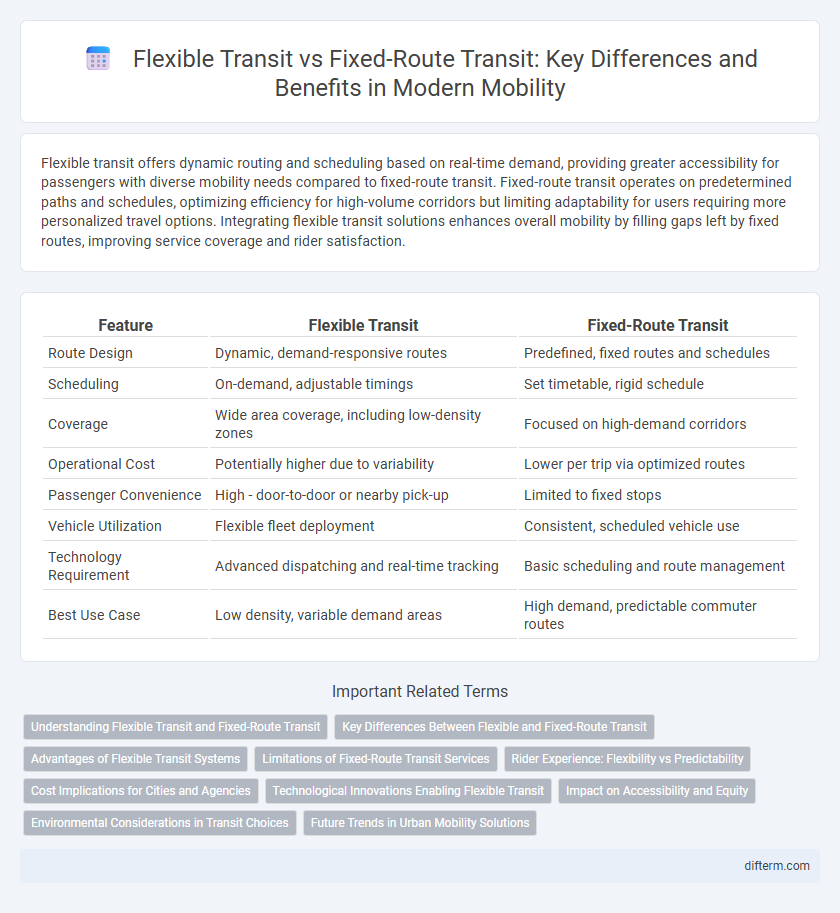Flexible transit offers dynamic routing and scheduling based on real-time demand, providing greater accessibility for passengers with diverse mobility needs compared to fixed-route transit. Fixed-route transit operates on predetermined paths and schedules, optimizing efficiency for high-volume corridors but limiting adaptability for users requiring more personalized travel options. Integrating flexible transit solutions enhances overall mobility by filling gaps left by fixed routes, improving service coverage and rider satisfaction.
Table of Comparison
| Feature | Flexible Transit | Fixed-Route Transit |
|---|---|---|
| Route Design | Dynamic, demand-responsive routes | Predefined, fixed routes and schedules |
| Scheduling | On-demand, adjustable timings | Set timetable, rigid schedule |
| Coverage | Wide area coverage, including low-density zones | Focused on high-demand corridors |
| Operational Cost | Potentially higher due to variability | Lower per trip via optimized routes |
| Passenger Convenience | High - door-to-door or nearby pick-up | Limited to fixed stops |
| Vehicle Utilization | Flexible fleet deployment | Consistent, scheduled vehicle use |
| Technology Requirement | Advanced dispatching and real-time tracking | Basic scheduling and route management |
| Best Use Case | Low density, variable demand areas | High demand, predictable commuter routes |
Understanding Flexible Transit and Fixed-Route Transit
Flexible transit adapts routes and schedules based on real-time demand, enhancing accessibility and efficiency in low-density areas. Fixed-route transit operates on predetermined paths and timetables, providing predictable service for high-demand corridors with consistent passenger volumes. Comparing both systems highlights flexible transit's ability to reduce wait times and improve coverage, while fixed-route transit ensures reliability and simplicity for daily commuters.
Key Differences Between Flexible and Fixed-Route Transit
Flexible transit adapts routes and schedules based on passenger demand, offering door-to-door or stop-to-stop service, which enhances accessibility and reduces wait times. Fixed-route transit operates on predetermined paths with set schedules, providing predictable and frequent service primarily suited for high-density corridors. The key differences lie in service adaptability, route rigidity, and user convenience, with flexible transit prioritizing customization while fixed-route transit emphasizes reliability and coverage.
Advantages of Flexible Transit Systems
Flexible transit systems offer significant advantages including improved route adaptability to real-time demand, enhancing service coverage in low-density or underserved areas. These systems reduce wait times and allow for dynamic scheduling, which boosts rider convenience and operational efficiency. By optimizing vehicle deployment, flexible transit lowers operational costs and environmental impact compared to fixed-route transit.
Limitations of Fixed-Route Transit Services
Fixed-route transit services often suffer from inflexibility due to predetermined routes and schedules, limiting their ability to adapt to fluctuating passenger demand and diverse travel patterns. These rigid systems can result in underutilized capacity during off-peak hours and overcrowding during peak times, reducing overall efficiency and rider satisfaction. Furthermore, fixed routes may not adequately serve low-density or evolving urban areas, leaving gaps in coverage that flexible transit models can more effectively address.
Rider Experience: Flexibility vs Predictability
Flexible transit offers riders customizable routes and schedules, enhancing convenience and reducing wait times compared to fixed-route transit. Fixed-route transit, however, provides predictable schedules and consistent stops, simplifying trip planning and reliability. Rider preference often depends on balancing the need for adaptability against the value of dependable service frequency.
Cost Implications for Cities and Agencies
Flexible transit systems often reduce operational costs by optimizing routes based on real-time demand, contrasting with fixed-route transit which incurs higher expenses due to predetermined schedules and underutilized capacity. Cities benefit from flexible transit by lowering capital investments in infrastructure, such as bus stops and dedicated lanes, while transit agencies experience improved resource allocation and decreased fuel consumption. Cost savings in flexible transit enable more scalable and adaptive mobility solutions suited for varying urban densities and fluctuating rider patterns.
Technological Innovations Enabling Flexible Transit
Technological innovations such as real-time data analytics, GPS tracking, and mobile app-based booking systems have revolutionized flexible transit by enabling dynamic routing and on-demand scheduling. Advanced algorithms optimize vehicle deployment, reducing wait times and operational costs compared to traditional fixed-route transit. Integration of electric and autonomous vehicles further enhances the efficiency and sustainability of flexible transit services.
Impact on Accessibility and Equity
Flexible transit enhances accessibility by providing on-demand transportation tailored to diverse user needs, bridging gaps in underserved or low-density areas where fixed-route transit often falls short. This adaptability promotes equity by ensuring marginalized populations, including seniors and individuals with disabilities, have reliable mobility options beyond rigid schedules and routes. Fixed-route transit, while efficient in high-demand corridors, may inadvertently limit access for those outside established transit lines, reinforcing disparities in mobility access.
Environmental Considerations in Transit Choices
Flexible transit services reduce carbon emissions by optimizing routes based on real-time demand, minimizing empty vehicle miles compared to fixed-route transit. Fixed-route transit often operates on predetermined schedules and paths, which can lead to underutilized capacity and higher emissions per passenger mile. Integrating flexible transit options can improve environmental sustainability by decreasing fuel consumption and lowering the overall carbon footprint of urban mobility systems.
Future Trends in Urban Mobility Solutions
Flexible transit systems adapt routes and schedules in real-time based on passenger demand, offering increased efficiency and coverage compared to fixed-route transit. Emerging technologies such as AI-driven algorithms and mobile apps enable seamless on-demand ride matching, reducing wait times and operational costs. Future urban mobility solutions prioritize integrating flexible transit with multi-modal networks to enhance accessibility and reduce congestion in rapidly growing cities.
flexible transit vs fixed-route transit Infographic

 difterm.com
difterm.com